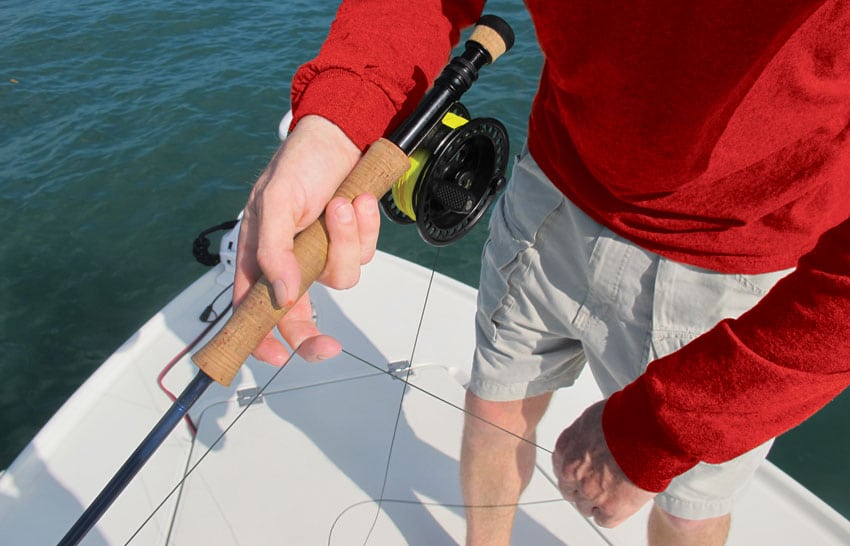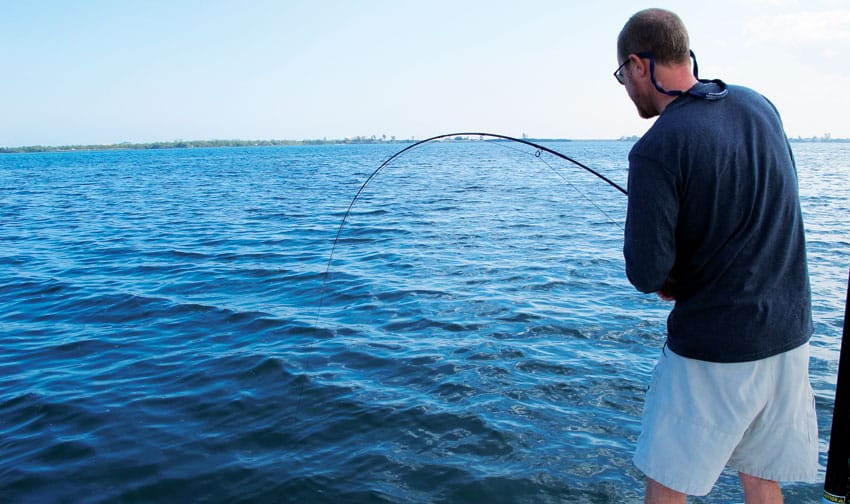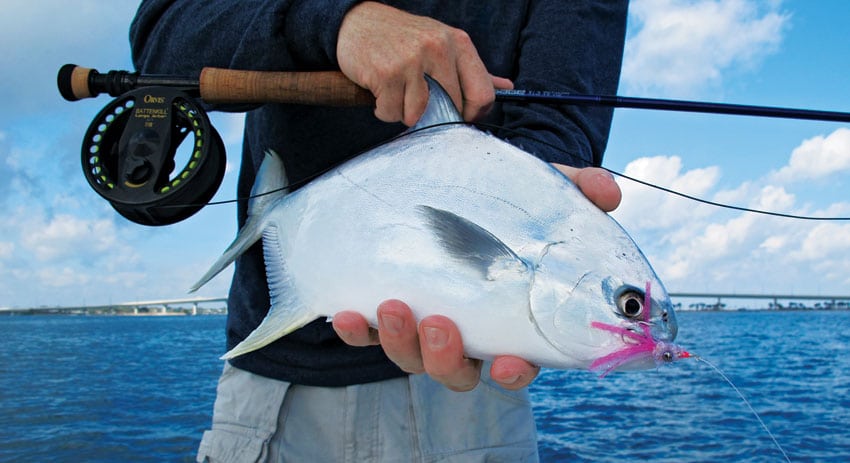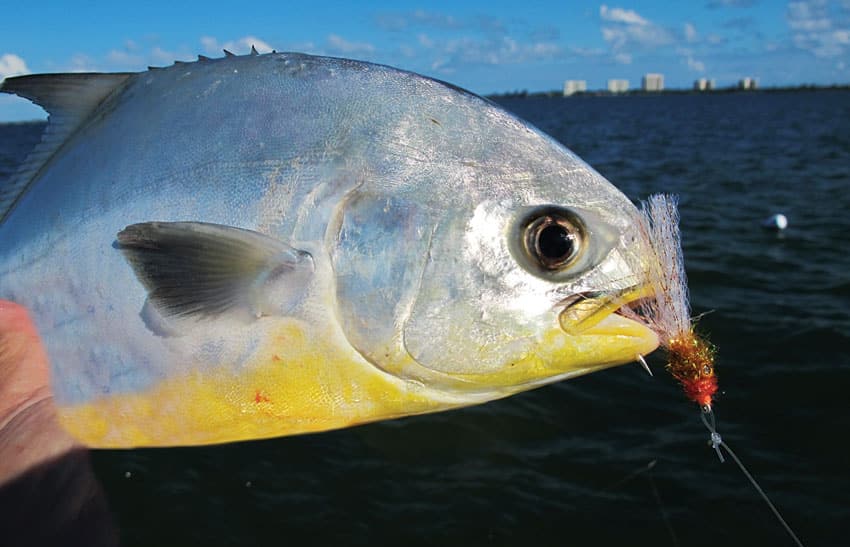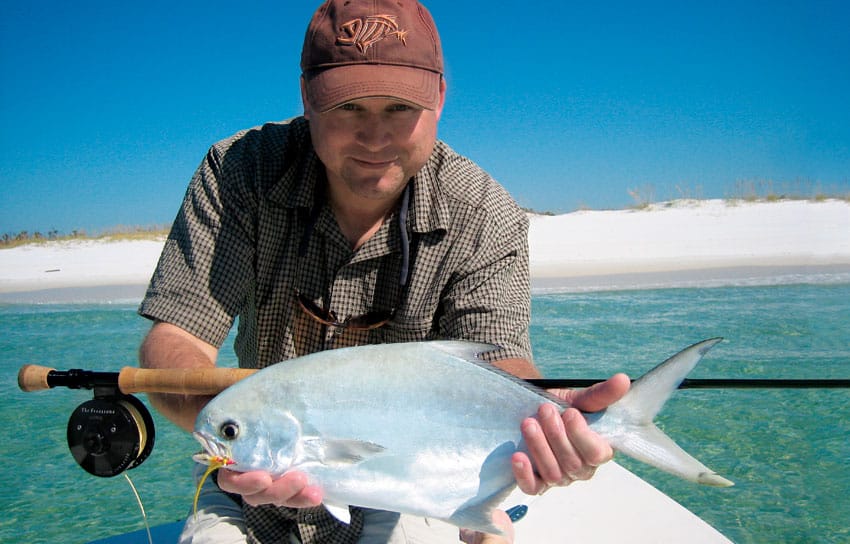
First came the jolt. Then a flash. I strip-struck, but my fly pulled free.
“Man, how did I miss that?” I wondered aloud.
Another strip or two, and I saw another flash and then felt a jolt. This fish struck on the run and was hooked solid. It spun a tight circle or two and hit the throttle. I cleared 20 feet or so of loose fly line from the deck onto the reel and then looked up just in time to spot the fish’s dark back as it streaked across the shallow crown of the shell bar off my bow.
“Geez, now it decides to slide up on there?” I laughed. “Most hooked fish run off a flat to deep water, not the other way around!”
“I guess that pompano is still new to this flats-fishing stuff,” my friend Richard Kernish suggested.
This was a really good pomp and didn’t slow down until it was about 40 yards out. Within a few minutes, I was able to reel my fly line back through the tip top, and then I applied a little side rod pressure. In response, the fish powered away once more on a shorter run before settling into jack mode, circling the skiff stubbornly until Kernish slid the net under the solid 3-pounder.
“Man, how many 3-pound fish fight like that?” I mused. “Well, other than bones and permit?”
We admired the characteristic silvery flanks but noticed this fish had a dark-olive back and deep-yellow fins, both signs it had been in Florida’s Indian River Lagoon for a while.
Before I hooked that fish, we had scanned that piece of light-colored shoal bottom under a sun-washed sky for a half-hour without spotting anything. So we went ahead and blind-cast our flies in deeper water along the drop-off. And that confirmed the pomps were there but not yet ready to flood the flat.
We fished through the afternoon rising tide, poling on the shallows and using the electric motor along the deeper edges of a handful of submerged Indian River shoals south of Fort Pierce. Of the dozen or so fish we landed, three or four were taken by sight-casting over light shell bottom — a challenging approach that certainly adds an element of excitement. The balance took our flies in three to five feet over the dark grass “aprons” encircling the shoals. The fish that we spotted traveled in schools of three to five and attacked our flies aggressively.
**
A Jekyll-and-Hyde Demeanor**
In my early pompano pursuits, the fish’s Jekyll-and-Hyde demeanor was readily apparent. Though pompanos are far more aggressive strikers of artificial lures and flies than their bigger permit cousins, the fish can be very spooky in clear, shallow water, and the slightest disturbance puts them on edge. If you’ve ever seen a pompano skip along the surface like a flat stone, you probably agree. They skip in the wakes of boats under way, but also when a boat simply drifts over them or when they detect the sound of an electric motor. Needless to say, they bite best when in a relaxed state, so you should practice stealth whether you are drift-fishing in six feet of water or poling or motoring while casting on shallower flats.
Then there’s pompano’s jack mode — usually displayed in deeper water. In January I joined a fleet of over 20 boats working an apparently massive school of fish just inside St. Lucie Inlet. Stealth was not being practiced that day. In fact, anglers were motoring through the pack to restart drifts, some running along at speed, making all sorts of racket, and the fish continuously skipped at the surface in fright. Spinner sharks often moved in for a kill and jumped for joy, perilously close to boats at times. Yet everyone caught limits on jigs in short order. My partner and I were the only ones fly-fishing, and we did very well. But it was hardly typical pompano behavior, and this was far from a wilderness experience.
Pompano primarily feed off the bottom; however, they are opportunistic and will forage in the middle of the water column and even on the surface sometimes. Occasionally pomps have been taken on topwater offerings — after all, they are jacks. Off the beach, the fish primarily scan the ocean floor for small crabs, sand fleas and myriad clams, such as tiny coquina. However, upon entering coastal bays and the Intracoastal Waterway (ICW), they feed not only on small crabs, mollusks and shrimp but on small baitfish as well. I have on more than one occasion cleaned a pompano and found glass minnows and even gobies in its gut. Otherwise, small shrimp and crab parts and crushed clamshell dominate. Needless to say, shrimp, small baitfish, crab and gaudy attractor patterns are all effective, particularly if weighted to sink fast.
Seasonal Trends
Though pompano are scattered throughout Florida waters in summer, the first real wave of fish shows in the surf in early fall. In September, the swash zone of Atlantic beaches is alive with juvenile pompano and permit (they are tough to tell apart in this stage) from the size of a dime to about 2 or 3 inches long. Like mature fish, they are there for the surf bounty — in this case, tiny sand fleas, coquina clams and various copepods dislodged by the wave action. Surf anglers catch a number of these last little guys in their mesh rakes while digging for sand fleas, a favorite bait for pompano in the surf. Pompano grow fast, and these diminutive pomps can reach legal size (in Florida, 11 inches from nose to tail fork) in about a year.
For most fly-fishers, pompano are most readily available once they enter the inlets on the Atlantic coast and pass on the Gulf side where, like permit, they forage over grass flats and shelly bars in coastal bays or the ICW. In my home waters, from Hobe Sound to Fort Pierce, I consider Thanksgiving the “soft” opening of pompano season, and the fishing all depends on the timing of the first cold fronts. It is believed the fish migrate from South Atlantic to Florida waters, and also from offshore waters in the fall. Many anglers assume pompano are cold-water fish, but the opposite is true. They can tolerate cold water, but I find and catch most of my fish in 70- to 78-degree water. After this year’s freezes knocked the temps below 64 in my local waters, the pomps vacated the ICW and streamed down the coast to the Palm Beach County surf, where the water was in the low 70s. If limited to fishing four months a year, I would choose November and December and March and April. That’s when water temps are normally ideal for pompano on Florida’s south east Atlantic coast.
On Florida’s Gulf coast, Sarasota and Tampa bays and Charlotte Harbor hold good numbers of fish starting in November. Sarasota’s Capt. Rick Grassett targets pompano over flats with salt-and-pepper bottom (mixed sand and grass), which provides the grazing fish a mix of crustaceans and baitfish.
“Fall sees an influx of pompano here, and spring fishing, particularly in April, can be excellent,” says Grassett. “Dead-of-winter water temps push them back out to the surf, where fly-fishing is not as effective. The trigger for inshore bays seems to be water temps in the low to high 70s. I do best where I find that temperature threshold over grass flats and sandbars closest to the Gulf passes. We do sight fish occasionally over the shallowest bars on a flood tide and even spot fish following stingrays much in the manner that redfish do.”
When Grassett isn’t sight-fishing, the lion’s share of his clients’ pompano catches come from water four to eight feet deep, and usually when the tidal current is strongest.
“Even when we are into fish, once the current halts at the tide change, the bite tapers off,” says Grassett. “In the shallowest water, I’ll choose a 7- or 8-weight rod with an intermediate sink-tip line, which allows an angler to pick up quickly to recast to a sighted fish, but for all-around pompano fishing, I prefer a clear full-intermediate line. I have experimented with 350-grain lines to probe deeper pass waters with some success too. As for flies, because pompano tend to short-strike, I tie chartreuse-and-pink short-winged Clouser Minnows with Ultra Hair and lots of flash. Depending on the depth, I tie them with bead-chain or lead eyes.
Surfside Sight-Casting
Though the surf is not the mainstream Florida pompano fly-fishery, the Panhandle beaches are an exception. Panhandle surf-fishing is the closest one can come to a bonefishing or permit-fishing experience while pompano fishing.
“Sight-fishing for pompano in the Florida Panhandle surf is every bit as challenging and rewarding as bonefishing,” says Capt. Basil “Baz” Yelverton of Gulf Breeze Guide Service, in Gulf Breeze. “The fish are curious, but in our clear water over blindingly white sand, they are understandably nervous and very unpredictable. One fish may charge a fly and eat it, and the next may follow it for 10 to 15 feet before committing or outright refusing it.
“I primarily sight-fish, so I pole an 18-foot Hewes Redfisher to access the shallowest water right against the beach” continues Yelverton. “Our bars have slightly deeper cuts that allow pompano to come in and out with the tide to not only feed but, according to local pompano gurus, escape predators in deeper water. I can position my boat close to these cuts and watch single fish or small schools move through to get to the beach just like permit do in other places.
“The tough part is spotting fish that are essentially swimming mirrors that have the ability to vanish when turning their side toward you. Over our white sand, you may only see the fish’s shadow, or if you’re lucky, a flash. Like bonefish or permit, pompano are easiest to see when they are approaching head-on or swimming straight away. The back is comparatively dark. You have to deal with a number of missed opportunities because sometimes you spot fish that have already seen you and are leaving the scene.”
Yelverton has experimented extensively with fly retrieval and claims that short, quick “bonefish” strips, with slight pauses to allow the fly to sink, are best.
“Without a doubt, single pompano are most challenging,” says Yelverton. “A single often follows the fly but then veers off. I urge my clients to not pick up and recast. It’s best to keep stripping the fly because, more times than not, the fish will return to either track or eat the fly. Singles tend to be flighty. Small schools are another story. Competition comes into play, and they typically fight over a well-presented fly as long as they are not alarmed.”
Springtime is Yelverton’s favorite period, and ideal conditions include bright sun and winds from the north, which create a lee on Panhandle beaches. Once a cold front passes, it takes about two days for north winds to clean up the roiled surf to allow for sight-fishing.
“The fish typically show by the end of March, and by April we’re in the thick of it,” says Yelverton. “May is excellent too, but by then ladyfish raid our surf, which presents a problem. The ladies often beat the pomps to the punch, so it becomes even more challenging to present your fly close enough to the pomp to feed it without spooking it.”
I would certainly add pompano to the growing list of bona fide Florida fly-rod sport fish and am excited about the prospect of developing more sight-fisheries for this scrappy, good-eating battler statewide. This fish has come on strong in the past few years and is developing quite a following among fly-fishers. It’s a great fish for beginner and advanced fly-fishers alike. Give it a try this fall.
Planning for Pompano
Rods: Suitable rods for pompano range from 6- to 9-weights. Many fly-fishers automatically think that anything over a 7-weight is overkill because these fish average 1½ to 3 pounds, with an occasional bigger specimen. But I would advise you to consider the weight of the fly you plan to fish, not the size of pompano. The best pompano flies are those that sink like a stone, which require heavy lead eyes. Heavier rods make it much easier to effectively cast flies of this type.
Lines: Floating lines make sense when fishing shallow bars and flats, but clear intermediate lines come in handy when you need to get the fly into the zone faster. For blind-casting in deeper water, switch to an outfit with a medium-rate full-sinking line, such as a Scientific Anglers Uniform Sink.
**
Leaders:** When fishing with a floating line, use a tapered flats-style leader that measures at least 8 feet in length with a 12-pound tippet. For blind-casting situations, there’s no need for anything fancy. Simply loop a 4-foot level piece of 15-pound fluorocarbon to your fly line and tie that directly to your fly. Because pompano are not particularly leader-shy (unlike their cousin, the permit), you can get away with using heavier leader setups, which is a good idea, especially when fishing in areas where other species are likely to be.
Flies: Pompano love eating sand fleas, but because of their natural shape, they are not an easy critter to accurately represent in the form of a fly. Therefore, I opt for patterns that are brightly colored and have lots of movement when stripped. Chartreuse-and-white, yellow, and hot-pink Clouser Minnow patterns work well, but the very best pompano flies are those that emulate the look and action of a conventional jig — streamlined and fast sinking. When pompano consistently pass on gaudy, flashy patterns, I will often switch to other proven patterns, such as Borski Critter Crabs and even larger-size Gotchas or Crazy Charlies.
Guides
Capt. Mike Conner
772-521-1882
www.captmikeconnerfishing.com
Capt. Baz Yelverton
850-934-3292
www.gulfbreezeguideservice.com

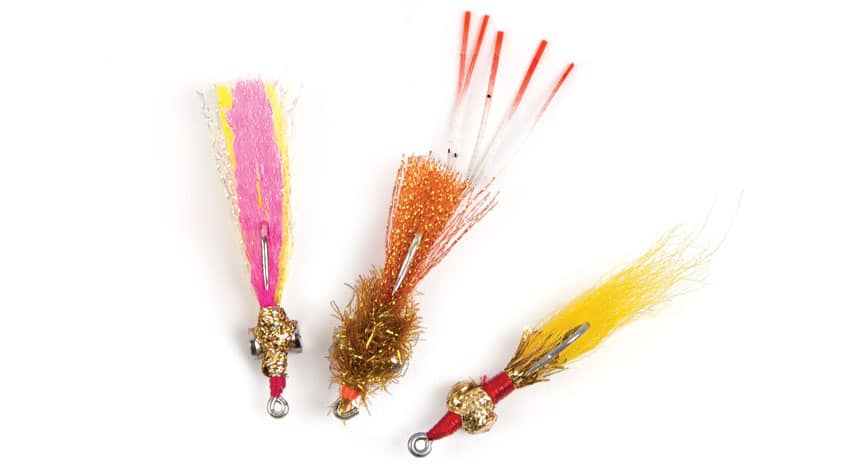
Pompano on Fly
